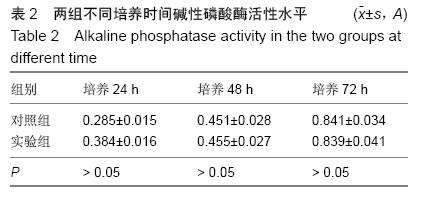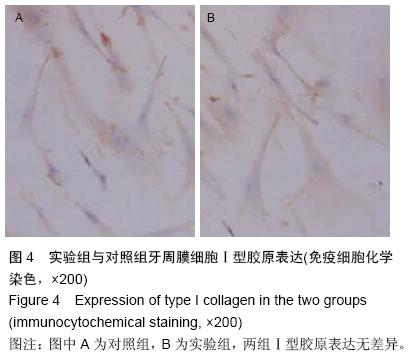| [1] 王琳,冯海兰,梅芳,等.人牙周膜细胞在左旋聚乳酸/羟基磷灰石生物材料上的生长观察[J].解剖学报, 2008,39(4): 573-577.[2] 贺慧霞,刘洪臣,王东胜,等.矿化液促进犬牙周膜细胞异位成骨实验[J].中华老年口腔医学杂志,2008,6(3):159-163.[3] 刘泉,莫安春.钇-羟基磷灰石纳米微粒对人牙周膜细胞生物学行为的影响[J].牙体牙髓牙周病学杂志, 2008,18(3): 139-143.[4] Wu C,Zhou Y,Lin C,et al.Strontium-containing mesoporous bioactive glass scaffolds with improved osteogenic/cementogenic differentiation of periodontal ligament cells for periodontal tissue engineering.Acta Biomaterialia.2012;8(10):3805-3815.[5] 王琳,邓旭亮,梅芳,等.电纺左旋聚乳酸和左旋聚乳酸羟基磷灰石纳米纤维细胞相容性的比较研究[J].口腔颌面修复学杂志,2007,8(2):83-86.[6] Xiang L,Ma L,He Y,et al.Transfection with follicular dendritic cell secreted protein to affect phenotype expression of human periodontal ligament cells.J Cell Biochem.2014;115(5):940-948.[7] Ji K,Liu Y,Lu W,et al.Periodontal tissue engineering with stem cells from the periodontal ligament of human retained deciduous teeth.J Periodontal Researc. 2013; 48(1):105-116.[8] Ji K,Liu Y,Lu W,et al.Periodontal tissue engineering with stem cells from the periodontal ligament of human retained deciduous teeth.J Periodontal Res. 2013; 48(1):105-116.[9] 石铁,王泓杰,高秀秋,等.纳米羟基磷灰石及其复合材料对牙周膜细胞的影响[J].中国组织工程研究与临床康复, 2009,13(3):553-556.[10] 王方,谢诚,吴国锋,等.组织工程牙周膜细胞片的体内实验研究[J].实用口腔医学杂志,2011,27(2):177-180.[11] 孙卫斌,吴亚菲,丁一,等.纳米羟基磷灰石对人牙周膜细胞的增殖效应[J].南京医科大学学报(英文版), 2004,18(6): 288-292.[12] 鲁红,吴织芬,田宇,等.一种新型纳米羟基磷灰石材料应用于牙周组织工程的可行性研究[J].牙体牙髓牙周病学杂志,2005,15(1):6-9.[13] Kuo TF,Huang AT,Chang HH,et al.Regeneration of dentin-pulp complex-with cementum and periodontal ligament formation using dental bud cells in gelatin- chondroitin-hyaluronan tri-copolymer scaffold in swine. J Biomed Mater Res A.2008;86A(4):1062-1068.[14] Chen K,Xiong H,Huang Y,et al.Comparative analysis of in vitro periodontal characteristics of stem cells from apical papilla (SCAP) and periodontal ligament stem cells (PDLSCs).Arch Oral Biol.2013;58(8):997-1006.[15] Martinez C,Rath S,VanGulden S,et al.Periodontal ligament cells cultured under steady-flow environments demonstrate potential for use in heart valve tissue engineering.Tissue Eng Part A.2013;19(3/4):458-466.[16] 孙卫斌,吴亚菲,丁一,等.纳米羟基磷灰石对人牙周膜细胞增殖活性的影响[J].东南大学学报(自然科学版), 2004, 34(6):802-805.[17] 毛钊,毛曦,储成林,等.人牙周膜细胞接种于纳米-羟基磷灰石上的形态学研究[J].东南国防医药, 2008,10(3): 161-163.[18] 鲁红,吴织芬,田宇,等.应用细胞-支架构建方式的组织工程方法促进牙周组织再生的实验研究[J].牙体牙髓牙周病学杂志,2005,15(1):14-18.[19] Kim YT,Park JC,Choi SH,et al.The dynamic healing profile of human periodontal ligament stem cells: Histological and immunohistochemical analysis using an ectopic transplantation model.J Periodontal Res. 2012;47(4):514-524.[20] Ripamonti U,Parak R,Petit JC,et al.Induction of cementogenesis and periodontal ligament regeneration by recombinant human transforming growth factor-beta3 in Matrigel with rectus abdominis responding cells.J Periodontal Res.2009;44(1):81-87.[21] 毛钊,尹英,毛曦,等.老年人牙周膜细胞附着于纳米-羟基磷灰石上的形态学观察[J].医学研究生学报, 2009,22(8):815-818[22] Liu W,Konermann A,Guo T,et al.Canonical Wnt signaling differently modulates osteogenic differentiation of mesenchymal stem cells derived from bone marrow and from periodontal ligament under inflammatory conditions.BBA Gen Subjects. 2014; 1840(3):1125-1134.[23] Chandrasekaran S,Ramachandran A,Eapen A,et al.Stimulation of periodontal ligament stem cells by dentin matrix protein 1 activates mitogen-activated protein kinase and osteoblast differentiation.J Periodontol.2013;84(3):389-395.[24] 鲁红,吴织芬.纳米羟基磷灰石材料复合碱性成纤维细胞因子促进牙周组织再生的实验研究[C].//2011第九次全国牙周病学学术会议论文集,2011:124-124.[25] 鲁红,吴织芬,田宇,等.人牙周膜细胞体外三维立体培养模型的建立[J].牙体牙髓牙周病学杂志, 2002,12(3): 132-134.[26] 鲁红,吴织芬,田宇,等.异体脱矿松质骨基质和纳米羟基磷灰石材料应用于牙周组织工程中的可行性探讨[J].中国临床康复,2002,6(17):2538-2539.[27] Moshaverinia A,Xu X,Chen C,et al.Application of stem cells derived from the periodontal ligament orgingival tissue sources for tendon tissue regeneration. Biomaterials.2014;35(9):2642-2650.[28] Yang Z,Jin F,Zhang et al.Tissue engineering of cementum/periodontal-ligament complex using a novel three-dimensional pellet cultivation system for human periodontal ligament stem cells. Tissue Eng Part C Methods.2009;15(4):571-581.[29] Sumita Y,Ikeda M,Ikeda H,et al.Engineering bone formation from human dental pulp- and periodontal ligament-derived cells.Ann Biomed Eng. 2011;39(1): 26-34.[30] 孙卫斌,刘天佳,吴亚菲,等.纳米羟基磷灰石诱导人牙周膜细胞骨化分化的研究[C].//四川省口腔医学会成立大会暨第八次四川省口腔医学学术会议论文集,2005:35-38.[31] Du L,Yang P,Ge S,et al.Stromal cell-derived factor-1 significantly induces proliferation, migration, and collagen type i expression in a human periodontal ligament stem cell subpopulation.J Periodontol. 2012; 83(3):379-388.[32] Saminathan A,Vinoth KJ,Low HH,et al.Engineering three-dimensional constructs of the periodontal ligament in hyaluronan-gelatin hydrogel films and a mechanically active environment.J Periodontal Res. 2013;48(6):790-801.[33] 孙卫斌,吴亚菲,丁一,等.纳米羟基磷灰石诱导人牙周膜细胞碱性磷酸酶表达的研究[J].中华口腔医学杂志, 2006, 41(6):348-349.[34] 鲁红,田宇,吴织芬,等.珊瑚转化羟基磷灰石应用于牙周组织工程的细胞相容性和细胞毒性[J].中国组织工程研究, 2012,16(16):2955-2958. [35] Kuo TF,Huang AT,Chang HH,et al.Regeneration of dentin-pulp complex with cementum and periodontal ligament formation using dental bud cells in gelatin-chondroitin-hyaluronan tri-copolymer scaffold in swine.J Biomed Mater Res Part A. 2008;86(4):1062-1068.[36] Bai Y,Matsuzaka K,Hashimoto S,et al.Cementum- and periodontal ligament-like tissue formation by dental follicle cell sheets co-cultured with Hertwig's epithelial root sheath cells.Bone.2011;48(6):1417-1426.[37] 鲁红,吴织芬,田宇,等.细胞-支架构建方式的牙周组织工程实验研究[J].中华口腔医学杂志, 2004,39(3): 189-192.[38] Akman AC,Tigli RS,Gumusderelioglu M,et al. bFGF-loaded HA-chitosan: A promising scaffold for periodontal tissue engineering.J Biomed Mater Res A. 2010;92A(3):953-962. |









